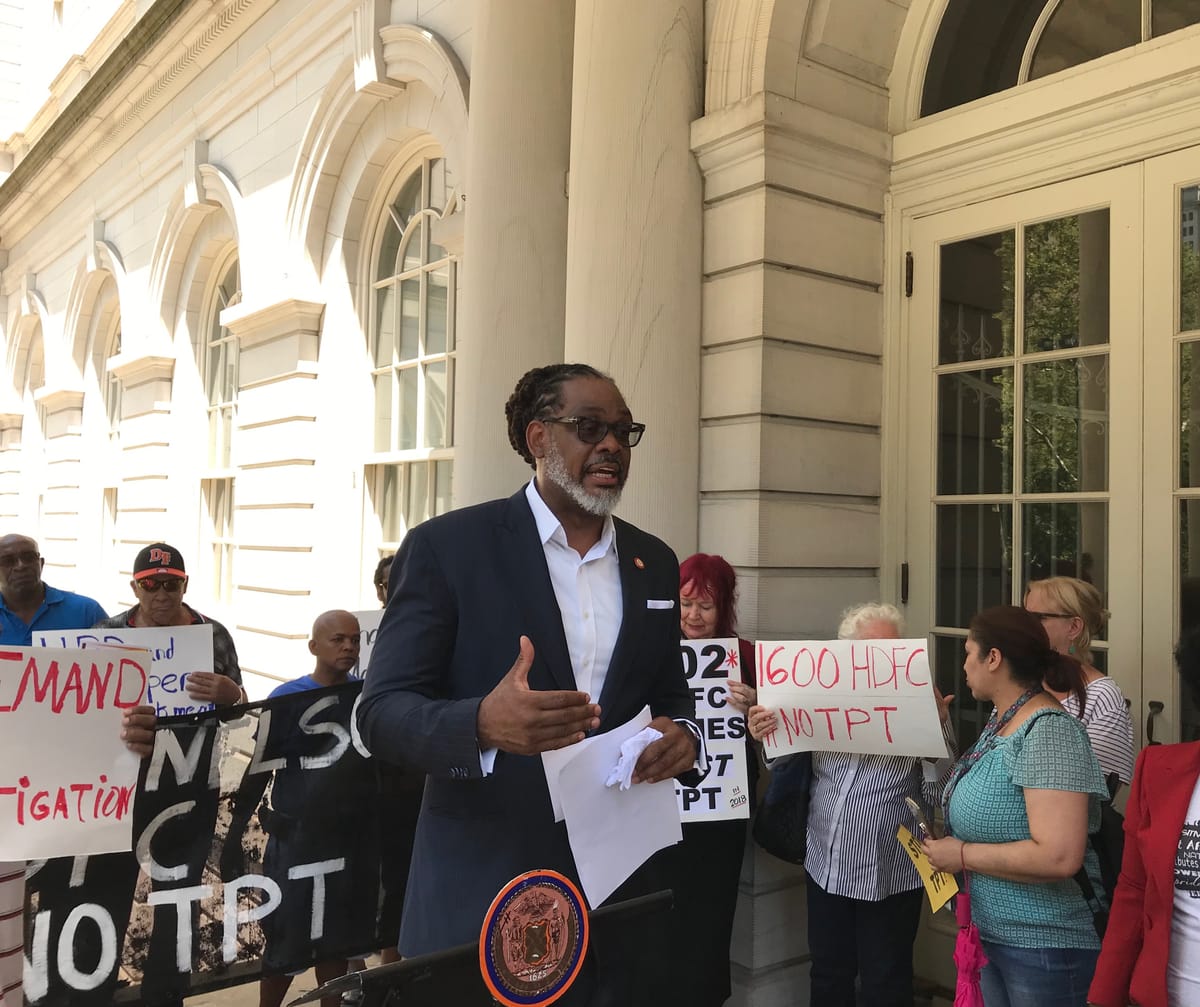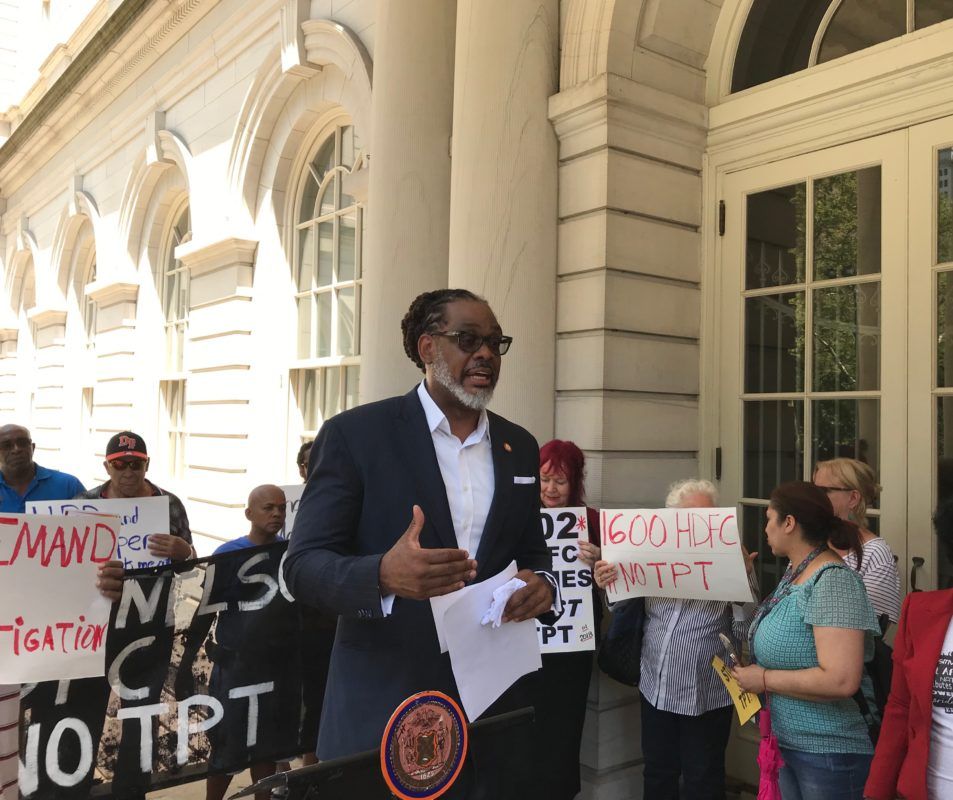City Housing Official Defends Heavily Scrutinized Third Party Transfer Program to Skeptical Council Members


CITY HALL — Mayor de Blasio’s housing commissioner on Monday made an adamant defense of a heavily criticized housing program that allows the city to take control of homes whose owners have accrued municipal debts.
The commissioner, Housing Preservation and Development’s Louise Carroll, also said she was open to changes to the controversial program, saying “everything is on the table” when pressed by City Council members at the heated afternoon hearing.
At issue is the Third Party Transfer Program, a program created in 1996 aimed at both collecting taxes along with other charges owed to the city and ensuring that homes are kept in good condition. If owners are unable to pay their debts or return homes to a state of good repair after their owners are notified of the situation, properties are foreclosed on and the city subsequently transfers their ownership to affordable and non-profit housing developers.
After the 1960s and ‘70s saw property abandonment and flight from the five boroughs, the city took control of many properties, but proved to be an inadequate landlord due in part to lacking sufficient resources to manage them at the time. In turn, TPT was formed to give the foreclosed-on properties to comparatively well-capitalized private owners.
The properties included in the third-party transfers are separate from the ones in the annual tax lien sale, and are selected in rounds, the latest of which began in 2015. (Since the program’s inception, there have been 10 rounds of it). During the latest TPT program round, which ended in 2018 and included 420 buildings, the average property that ended up being transferred had more than $800,000 in unpaid taxes on it, and more than eight “hazardous or immediately hazardous” violations, according to Carroll.
Additionally, Carroll, appointed by Mayor Bill de Blasio in May, said the last round of TPT has recouped $40 million in arrears for the city and stressed that it did not include any single-family homes. Along with property taxes owed to the Department of Finance, arrears that count toward potential inclusion in TPT can include money owed to the Department of Environmental Protection for outstanding water or sewer bills.
In recent months, the program has come under scrutiny from Council members and advocates, who argue the city has been too quick to foreclose on properties, and that HPD intentionally targeted traditionally low-income black and brown neighborhoods where property values have risen over the last several years. That phenomenon, the program’s critics say, has robbed generational wealth and is reflective of the country’s ugly, racist history vis-à-vis race and homeownership in the United States.
“It seems the Third Party Transfer Program has veered way off course,” Council Member Robert Cornegy, who represents Bed-Stuy and northern Crown Heights, said outside City Hall ahead of the hearing. “Given that fact, it’s hard not to be deeply frustrated.”
Cornegy, who is running for Brooklyn borough president, said that his gentrifying district has been home to a disproportionate amount of third-party transfers. Along those lines, Cornegy noted at the hearing that just 10 properties in Queens had been selected for TPT and zero in Staten Island— the city’s whitest borough— while 32 properties were chosen during the last TPT around in the Bronx, and Brooklyn was home to 192 such properties.
“It seems as if there’s an unequal application of the law,” he said prior to Monday’s hearing. “What they’re taking away from us is intergenerational wealth.”
Cornegy echoed his concerns to Carroll at the joint housing and buildings committee and oversight and investigation committees hearing.
“It’s very difficult to remain tempered when the focus primarily has been in Brooklyn, in particular, in my district, which has the lion’s share of third-party transfers in northern Crown Heights,” he said. “It’s incredibly difficult watching the attempted transfer of wealth in communities of color … in the city, and the potential for the city to be culpable in some of that, and as chair, to remain silent.”
“Can you please explain how that cannot be seen as, at the very least, racially insensitive,” he later asked Carroll. “Why are so many properties concentrated in these particular neighborhoods, which are predominantly black and brown communities?”
Carroll insisted that race is not a data point the city uses for choosing properties for TPT.
“Council member, when we do the selections, we are not looking at racial data,” she responded. “All we are looking at it how much money is owed to the city.”
When you look at the map of the properties that are chosen for TP, Carroll said, they are disproportionately in areas with high foreclosures and “suffered greatly in 2008 during the mortgage crisis.”
“TPT does not target any specific neighborhood or community,” she explained in her prepared testimony. “It selects properties through a thoughtful process grounded in local law and focused on tax enforcement and rehabilitation for residential properties with municipal arrears.”
She went on to say that certain pockets of high amounts of TPT properties have emerged because of the law’s specification that one property’s meeting the qualifications for the program triggers an examination of all the properties on a tax lot.
“We are picking the [properties] that owe that most and when we do that, we are forced by the statute to also look at the properties around them that meet the minimum criteria,” she said in response to Cornegy’s line of questioning.
Still, Carroll said she recognized that there may be parts of TPT in need of being amended, and would be open to some of the Council member’s suggestions, though she notably did not commit to supporting any specific changes when asked to do so.
“There is always room for improvement,” said Carroll, “and we are committed to making the process as transparent and effective as possible and doing all we can to help homeowners avoid the spiral of financial and physical problems that put their properties at risk.”



